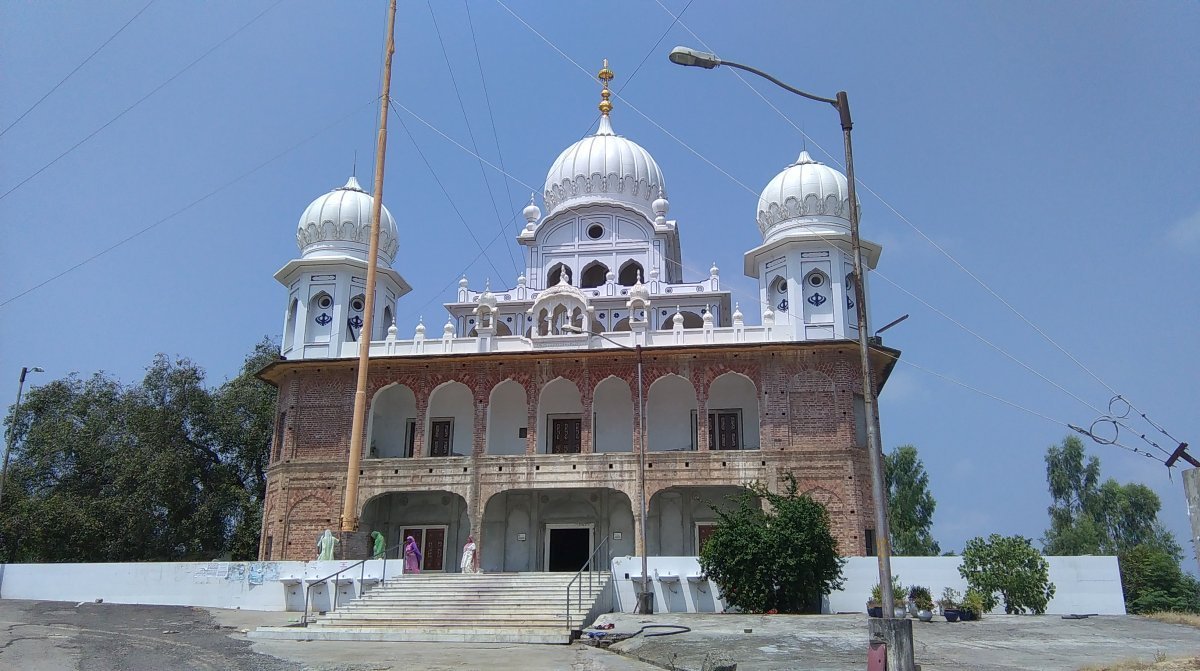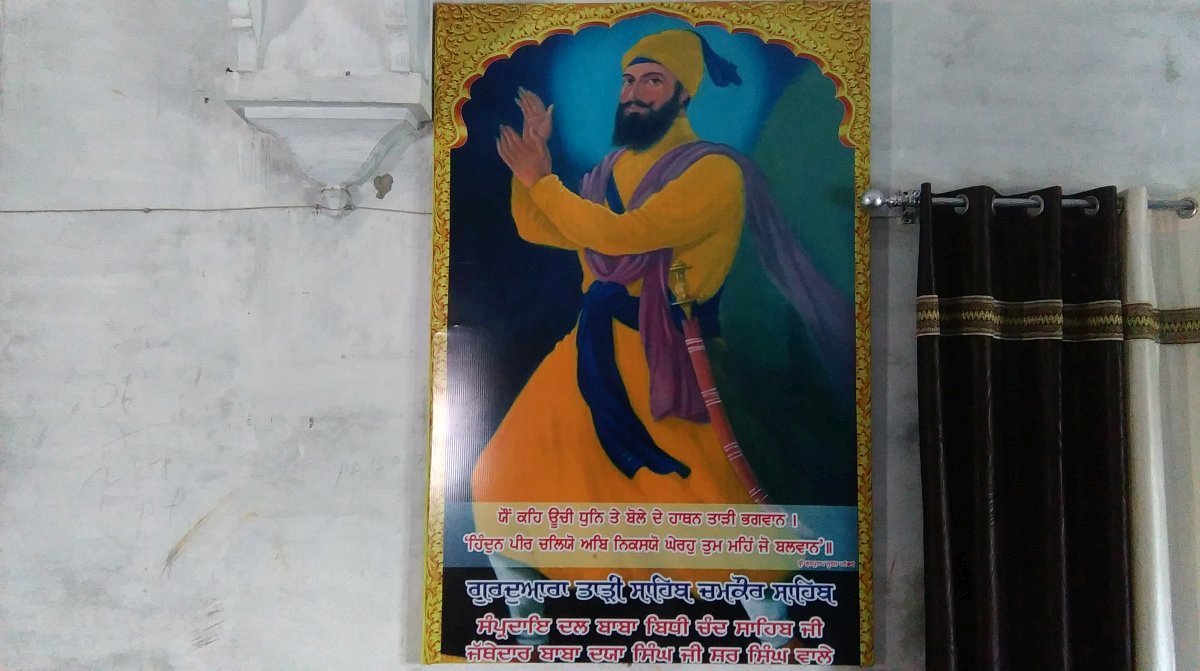Gurudwara Shri Taari Sahib is an important historical and religious site in Chamkaur Sahib, Punjab. This sacred place honors a key event during the Battle of Chamkaur in 1705, highlighting the strategic skill and spirit of the tenth Sikh Guru, Guru Gobind Singh Ji.

Historical Context: The Battle of Chamkaur
The Battle of Chamkaur in 1705 is one of the most remarkable events in Sikh history. It exemplifies the courage, resilience, and strategic brilliance of Guru Gobind Singh Ji, the tenth Sikh Guru. This battle took place at the fortress of Chamkaur, where Guru Gobind Singh Ji and a small group of Sikhs were besieged by a massive Mughal army. The Mughals, supported by allied hill chiefs, vastly outnumbered the Sikhs, making it a battle of sheer willpower and strategic ingenuity.
Despite being surrounded and heavily outnumbered, Guru Gobind Singh Ji remained calm and focused, demonstrating exceptional leadership. The Guru’s resolve and unwavering faith inspired his companions, even in the face of near-certain defeat. Recognizing the dire situation and the need to preserve the Khalsa ideals, Guru Gobind Singh Ji decided on a daring plan to evacuate the fortress rather than face annihilation.
Accompanied by three devoted Sikhs—Bhai Daya Singh, Bhai Dharam Singh, and Bhai Man Singh—the Guru planned a diversion to outwit the enemy. This act of strategic brilliance not only ensured their escape but also showcased the Guru's resourcefulness and his ability to adapt to challenging circumstances.
The Strategic Diversion at Taari Sahib
As part of the escape plan, Guru Gobind Singh Ji and his three companions took a route leading to a mound, now the site of Gurudwara Shri Taari Sahib. Upon reaching this spot, the Guru orchestrated a clever diversion to mislead the enemy forces. Standing atop the mound, Guru Gobind Singh Ji clapped his hands loudly and declared, “Here goes the Pir of Hind (the saint of India)!”
This proclamation was not merely a loud call; it carried symbolic significance. The title "Pir of Hind" was a declaration of spiritual authority and moral leadership that goes beyond the boundaries of religion and community. It also served to sow confusion among the pursuing Mughal forces.

Simultaneously, the Guru's three accompanying Sikhs—stationed at strategic points nearby—echoed similar shouts. These synchronized cries created an illusion of multiple groups of Sikhs dispersing in different directions. The Mughal forces, already disoriented by the unexpected retreat, became further baffled by the echoes and could not determine the Guru’s actual location. This ingenious ploy gave Guru Gobind Singh Ji and his companions the crucial time they needed to slip away from harm.
The site where this remarkable event took place is now commemorated by Gurudwara Shri Taari Sahib, a sacred reminder of the Guru’s tactical brilliance and his unwavering determination to uphold the Khalsa ideals. This Gurudwara stands as a testament to the Guru’s ability to turn even the most challenging situations into opportunities for triumph.
Through this act, Guru Gobind Singh Ji demonstrated that leadership is not only about fighting battles but also about using wisdom, strategy, and faith to overcome adversity.
Etymology and Significance of 'Taari'
The name ‘Taari’, which translates to "clap" in Punjabi, holds great historical and symbolic significance in the context of Gurudwara Shri Taari Sahib. This term directly refers to the act of Guru Gobind Singh Ji clapping his hands during the strategic diversion at this location. The hand-clapping was not just a physical gesture but a tactical move that showcased the Guru’s quick thinking and resourcefulness during a perilous escape.
The clap, accompanied by his proclamation of "Here goes the Pir of Hind," served as a pivotal element in baffling the Mughal forces. It exemplified how even a simple act, when executed with wisdom and presence of mind, can achieve significant results. The Guru’s ingenuity in using such a tactic to mislead the enemy demonstrates his deep understanding of strategy and his ability to inspire confidence in his followers even in moments of grave adversity.
The name ‘Taari’ immortalizes this act and reminds devotees of the Guru’s brilliance and leadership, reinforcing the lesson that courage and intelligence can overcome the most daunting challenges.
Architectural Features of Gurudwara Shri Taari Sahib
Gurudwara Shri Taari Sahib is not only a site of profound historical importance but also a beautiful representation of Sikh architecture. The structure of the Gurudwara harmoniously combines traditional Sikh design elements with modern architectural techniques, creating a serene and inviting space for worship and reflection.
The Central Shrine
At the heart of the Gurudwara lies the sanctum sanctorum, where the Guru Granth Sahib, the holy scripture of Sikhism, is enshrined. The Guru Granth Sahib is placed on a raised platform, signifying its spiritual prominence. The platform is adorned with an intricately designed canopy, adding to the sanctity and aesthetic appeal of the space.
The Prayer Hall
The prayer hall of the Gurudwara is spacious, accommodating a large number of devotees who gather for daily prayers and special congregations. The hall's design reflects the simplicity and humility that are central to Sikhism, while still offering a sense of grandeur through its clean lines and elegant décor. The open and inclusive nature of the space allows devotees to experience a sense of unity and peace during their visit.
The architectural layout is designed to encourage meditation and spiritual reflection, making the Gurudwara not just a historical site but also a vibrant center of devotion and community life. Whether one visits for personal prayers or to participate in larger gatherings, the ambiance of Gurudwara Shri Taari Sahib fosters a deep sense of connection to Sikh heritage and values.
Pilgrimage and Annual Celebrations
Gurudwara Shri Taari Sahib holds immense spiritual and historical importance, attracting pilgrims from around the world who come to pay their respects and connect with the legacy of Guru Gobind Singh Ji.
Prayers and Kirtan: Devotional singing, or kirtan, fills the air as devotees chant hymns from the Guru Granth Sahib, expressing their reverence and connection to the Guru’s teachings.
Langar: The tradition of langar, a free community meal, is upheld, reflecting the Sikh principles of equality and selfless service. People from all walks of life, regardless of caste, creed, or religion, share meals together, embodying the spirit of unity.
Storytelling and Discourses: Events are organized to narrate the historical significance of the Battle of Chamkaur and Guru Gobind Singh Ji’s strategic brilliance, inspiring visitors with the values of courage and faith.
Through these activities, the Gurudwara not only serves as a spiritual sanctuary but also as a hub for cultural and historical education.
Preservation of Heritage
Preserving the sanctity and historical importance of Gurudwara Shri Taari Sahib has been a priority for the Sikh community. The Gurudwara serves as a beacon of Sikh heritage, ensuring that future generations understand the profound events that took place during the Battle of Chamkaur.
Educational Role
The Gurudwara functions as an educational center, enlightening visitors about the pivotal moments in Sikh history. Guided tours and informational sessions help pilgrims learn about the significance of Guru Gobind Singh Ji’s escape and the strategic diversion that occurred at this sacred site.
Infrastructure and Maintenance
Efforts have been made to maintain and enhance the Gurudwara’s infrastructure while preserving its historical authenticity. These initiatives include:
Restoring architectural features to maintain the Gurudwara's historical integrity.
Creating spaces for visitors to meditate, reflect, and immerse themselves in the spiritual ambiance.
Adding modern facilities to accommodate the growing number of pilgrims while ensuring their comfort.
The continued focus on preservation ensures that the legacy of Gurudwara Shri Taari Sahib remains alive, inspiring generations to come with the values of faith, bravery, and selfless service.
Conclusion
Gurudwara Shri Taari Sahib is not merely a place of worship but a symbol of resilience, strategic brilliance, and the unyielding spirit of Guru Gobind Singh Ji. It stands as a living reminder of the rich history of Sikhism and continues to inspire devotees and visitors with its profound legacy. The Gurudwara's significance goes beyond its physical presence, as it reflects the strength and resolve of the Sikh community in challenging times.Its story is one of faith, sacrifice, and the commitment to uphold justice.
Note- We have made every effort to ensure the accuracy and reliability of the information provided. However, this content is intended for informational purposes only and reflects historical and cultural perspectives. DVN does not assume responsibility for any disputes or actions that may arise from the use of this content. If you believe any information is incorrect or misleading, please contact us.